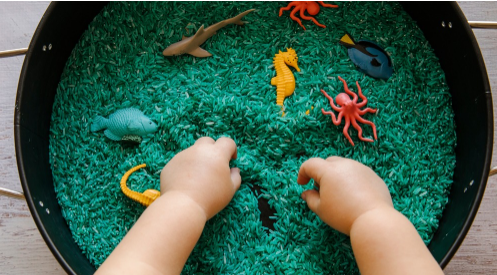
What Will You Need?
The materials used in a sensory station can vary widely, but they often include items such as:
- Textured Materials: These can include sand, water beads, rice, pasta, cotton balls, or other materials with distinct textures.
- Visual Stimuli: This can involve adding various colours, shapes, and objects that catch a child’s eye.
- Aromas: Introducing scents through herbs, flowers, or scented playdough.
- Auditory Elements: Incorporating materials that produce sounds, such as bells, shakers, or soft music.
- Tactile Objects: Offering objects that can be manipulated and touched, like small toys, scoops, brushes, and containers.
- Educational Themes: Designing sensory stations around specific themes (e.g., ocean, farm, outer space) to encourage learning through play.
- Nature Items: Using natural materials like leaves, pinecones, and stones for a more organic sensory experience.
Implementation
Sensory stations are simple low tables with a theme for kids to explore. Usually, the materials laid out are meant for as much independent discovery and sensory exploration as possible.
A sensory station for young kids is an excellent way for them to investigate, observe, and explore their interests at their own pace through their senses. These kinds of centres or tables are usually filled with kid-friendly materials that don’t need constant adult supervision.
How To Use A Sensory Station
Help the child to explore and wonder by asking simple open-ended questions. If the child is struggling with the materials below, model a way to use, feel, or smell it. Offer a turn, allow some time for the child to become familiar with the ideas and items, and then ask a few questions to get them thinking.
- Tell me, what are you doing?
- How does that feel?
- What does it sound like?
- How does it taste?
- Where did you think it came from?
More Sensory Station Tips and Tricks
Using a sensory station with young kids can be a fun and educational experience. Here are some tips to help you make the most of sensory play:
Materials
Choose Appropriate Materials: Select materials that are safe, age-appropriate, and encourage exploration. Consider the sensory experiences you want to provide, such as textures, colors, and scents.
Rotate Materials: Change the materials in the sensory station regularly to keep children engaged and curious. Different textures and themes can spark new interests.
Incorporate Learning: Use the sensory station to introduce educational concepts. You can count objects, sort by color, or discuss the properties of the materials (soft, rough, smooth, etc.).
Plan for Mess: Sensory play can get messy, so be prepared with aprons, smocks, or old clothes. You can also set up the sensory station in an easily washable or outdoor area.
Allow Open-ended Play: Let children take the lead in their play. Avoid giving specific instructions; instead, let them discover and create on their own.
Respect Preferences: Some children might be sensitive to certain textures or smells. If a child is hesitant, don’t force them to engage – allow them to observe from a distance if they prefer.
Group Play
Promote Social Interaction: If possible, set up the sensory station for group play. Children can learn to share, take turns, and collaborate while exploring together.
Encourage Communication: Ask open-ended questions to spark conversation. “How does that feel?” “What does it remind you of?” This promotes language development.
Clean Up Together: Teach responsibility by involving children in cleaning up after playtime. This can also be part of the sensory experience.
How To Set Up A Sensory Station
Use a divider tray or small baskets and bowls to hold your 5 senses items below. Choose a few or many items to explore each sense. Here are some items you could include in your sensory station…
Place your items on a low table that your kids can gather around. Some kids may find it more comfortable to stand and explore!
SIGHT:
Mirrors
Mini Flashlight
Postcards of artwork, places, and animals
Photographs of family and friends or people from around the world
DIY Kaleidoscope
Glitter Bottles
Homemade Lava Lamp
SMELL:
whole cloves
cinnamon sticks
lemon
flowers
Lemon Scented Rice
Scented Cloud Dough
Cinnamon Ornaments
Spice Paint
TASTE:
honey
lemon
a lollipop
pieces of fruit
Pop rocks
SOUND:
bell
shaker eggs
a whistle
container with rice
rain stick
water xylophone
TOUCH:
silk scarf
rough/smooth conch shell
leaves
large pine cone
tree pods
sandpaper
rainbow spaghetti
kinetic sand
homemade slime
Impact
Encourages all highlighted areas of learning
Category
- Communication and Language
- Personal , Social and Emotional Development
- Physical Development
- Literacy
- Mathematics
- Understanding the World
- Expressive Arts and Design

